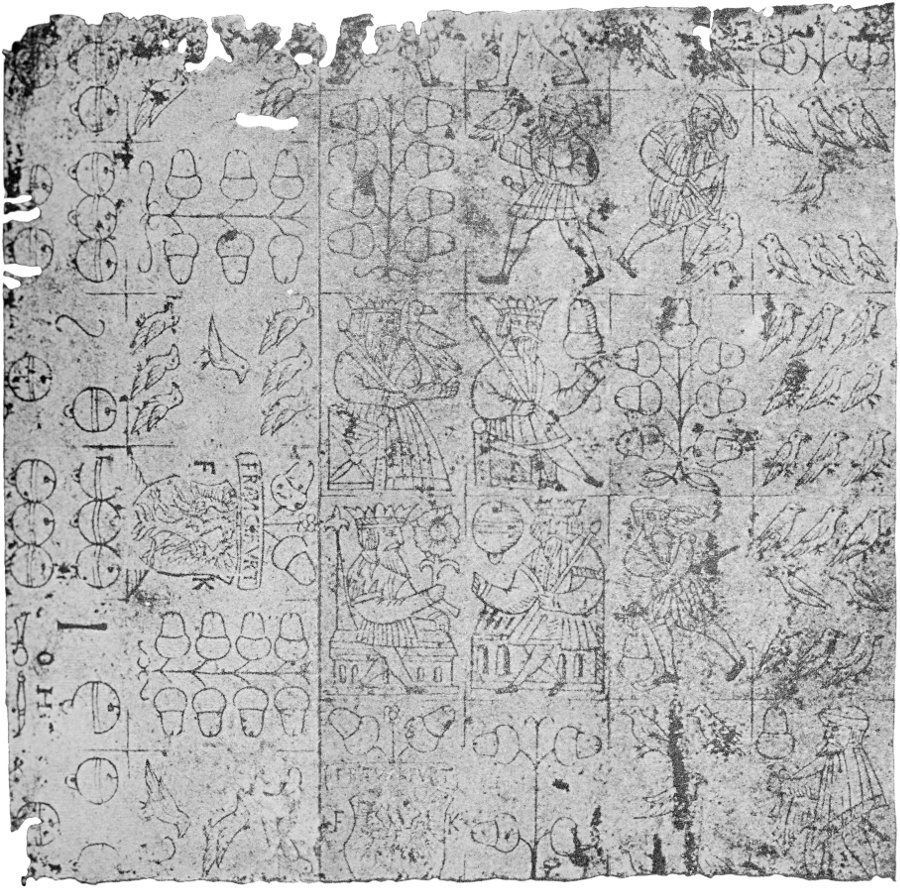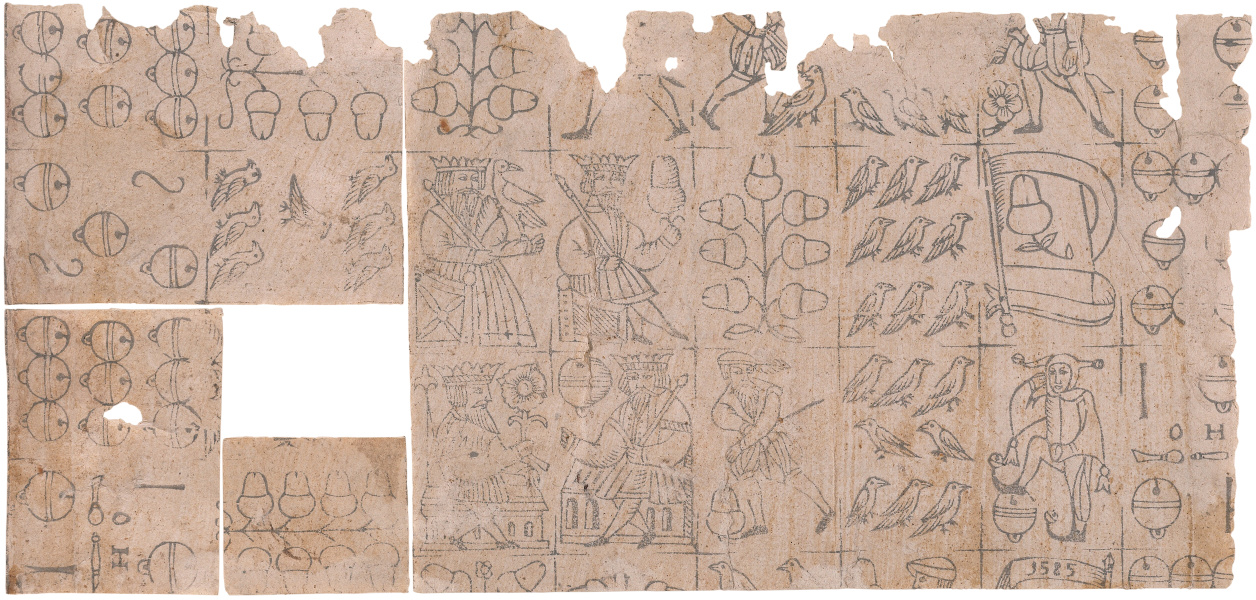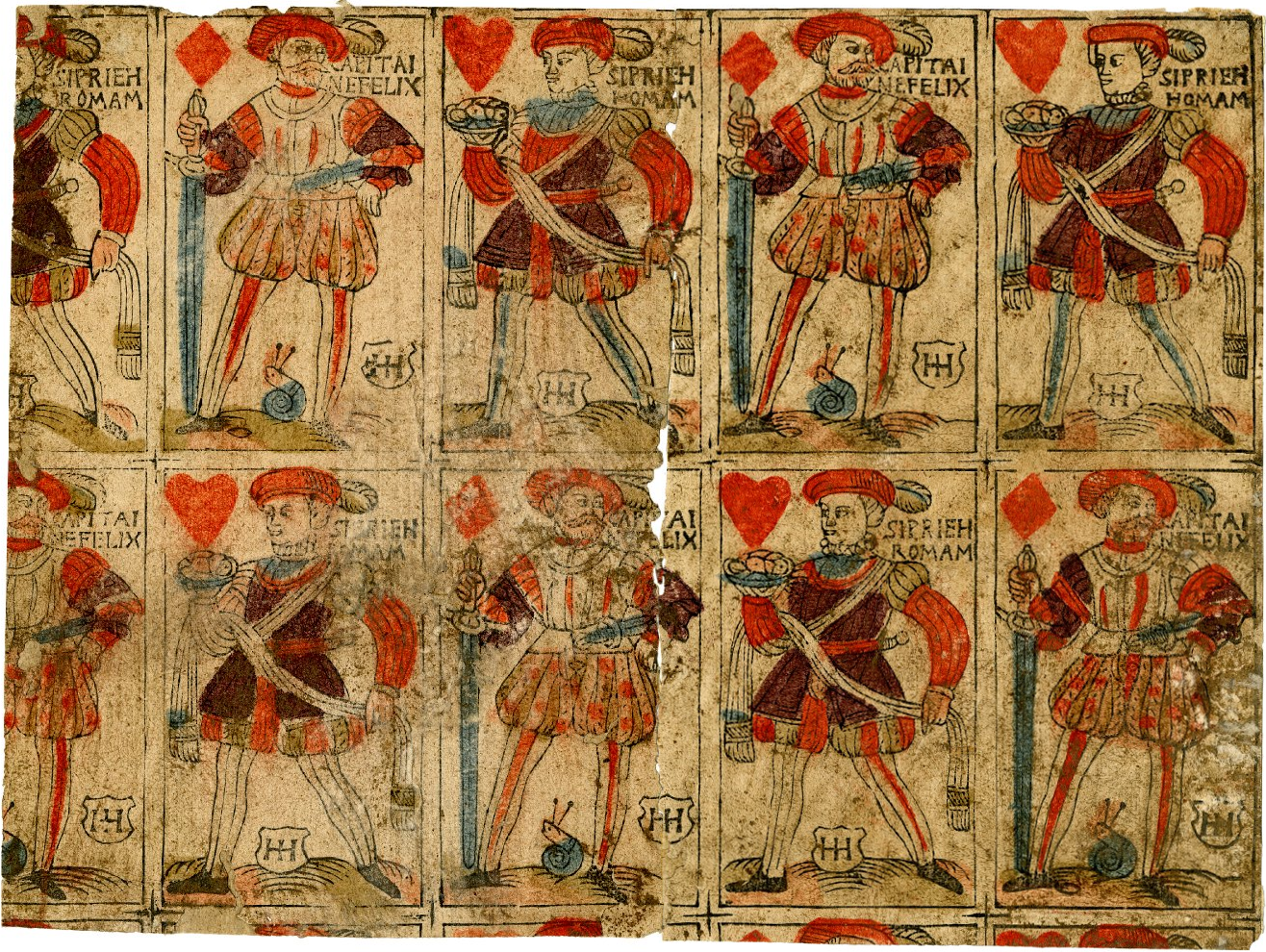Heinrich Hauk, Frankfurt, 1585
Between several large and small fragments of uncut sheets from the Cary Collection of Playing Cards at Yale University, the British Museum and the United States Playing Card Company collection, a miniature deck signed henrich hauck, franckfurt and dated 1585 is almost fully preserved. Fragments of several other decks by the same maker is known, and in other sources his name is spelled Heinrich Hauk. This deck is of particular interest because of the similarity to the Swiss suit system. Like that, this deck replaces leaves and hearts while retaining acorns and bells from the normal German suit system. One of the replacements is roses like in the Swiss system, but the other is birds rather than shields. Like standard German cards of the period and early Swiss cards, each suit contains twelve subjects: Daus (deuce), pip cards from three to nine, ten (here of the banner type), Unter (under-knave), Ober (over-knave) and King.
| Eicheln ❖ Acorns |
Vögel ❖ Birds |
Rosen ❖ Roses |
Schellen ❖ Bells |
|
|---|---|---|---|---|
| Daus ❖ Deuce (2) |
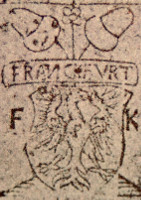 |
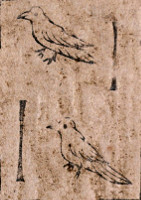 |
 |
 |
| 3 | 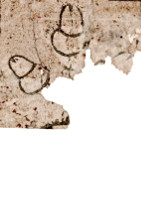 |
 |
 |
 |
| 4 |  |
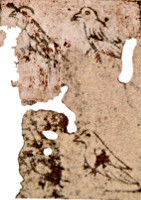 |
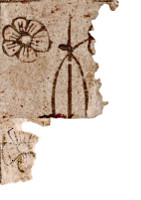 |
 |
| 5 | 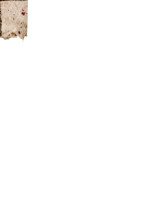 |
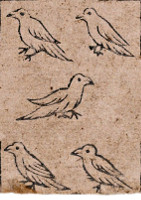 |
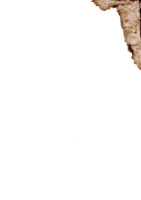 |
 |
| 6 |  |
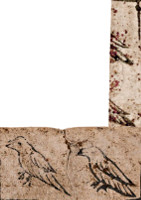 |
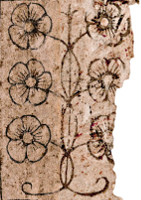 |
 |
| 7 | 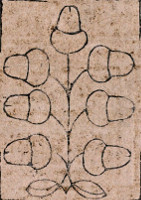 |
 |
 |
 |
| 8 | 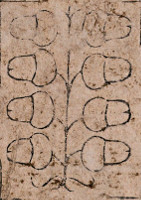 |
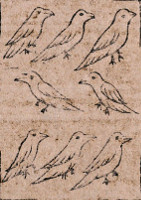 |
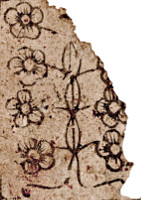 |
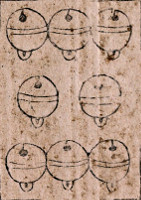 |
| 9 | 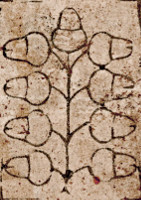 |
 |
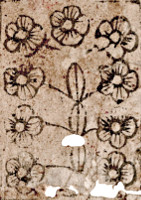 |
 |
| Banner (10) |
 |
 |
 |
 |
| Unter ❖ Under-knave |
 |
 |
 |
 |
| Ober ❖ Over-knave |
 |
 |
 |
 |
| König ❖ King |
 |
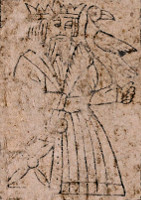 |
 |
 |
The surviving fragments belong to four sheets printed from three different woodblocks. These blocks form a set where each contains a main section with a complete set of 48 cards plus a section with duplicates of a third of these. The selection of duplicates is distributed between the blocks so that an imprint from each of the three blocks together make up four decks with the same designs. The surviving cards from blocks 1 and 2 are so close to identical that one of these blocks must be a direct copy of the other, or both being direct copies of the same source. The cards from block 3 and the duplicate sections differ slightly more from the former than those do from each other, but contain the same designs. The cards in the main sections measure 36 by 52 mm, while the duplicates are slightly wider and shorter, 39 by 50 mm.
Blocks 1 and 2
The largest fragment from the Cary collection consists of the bottom three quarters of block 1, minus a strip along the edges. The British Museum fragments fit together, forming the right-hand half of block 2, minus half a row of cards at the top and the bottom and some holes.
The close match between the surving parts of these two blocks mentioned above means that we safely can reconstruct much of the missing parts of block 1 using the surviving parts of block 2. This way, only the position of four cards from the main section and the identity and position of four cards in the duplicate section is unaccounted for. With educated guesses for these, one arrives at the following layout for sheet 1:
|
Eicheln ❖ Acorns
Vögel ❖ Birds
Rosen ❖ Roses
Schellen ❖ Bells
|
D = Daus ❖ Deuce (2)
3–9 = Pip cards
B = Banner (10)
|
U = Unter ❖ Under-knave
O = Ober ❖ Over-knave
K = König ❖ King
|
The main section of block 2 would presumably be identical, but the selection of duplicate cards must have been entirely different.
Block 3
The sheet in the collection of the United States Playing Card Company contains the lower three quarters of the left three fifths of block 3, minus a strip at the left and bottom edges. The four smaller fragments in the Cary Collection belongs to a sheet that has been deliberately cut apart, and a piece covering most of one card is subsequently lost. When reassembled, this sheet covers an area largely overlapping the USPC fragment. Compared to that, it lacks almost a full card height at the top and slightly less at the bottom, but contains two card widths more to the right and the missing third of a card to the left.
The layout of what is preserved of the main section is very similar to that of block 1, but two pairs of adjacent cards have switched places internally (underlined):
Interesting parallels
Either the source or an imitation of this deck was made by Hans Braun, in a larger yet still miniature size of 48×62 mm. A surviving sheet fragment in Heidelberg University Library contains deuce to nine of acorns and birds, six and seven of roses and a thin strip with the very bottom of three kings and three over-knaves. Just enough remains of the court cards to rule out that they have the same designs as Hauk’s cards. Besides the unusual suits, there is another strong connection: The coat of arms on the deuce of acorns shows three roses sprouting from a heart, just as on Hauk’s three of roses, but without the superimposed crossing bars there. This is a strong indication that it was Hauk who copied Braun and not vice versa.
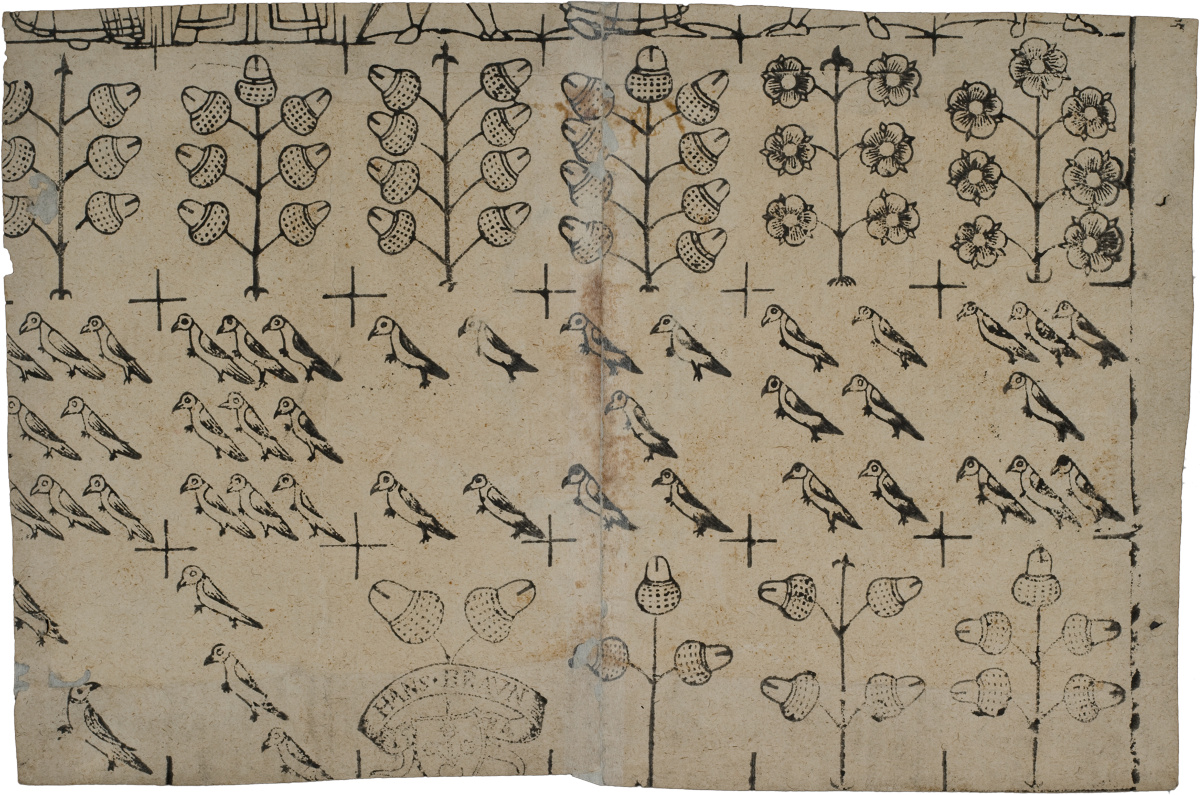
Though far cruder, Hauk’s deck shares a few details of the beautiful deck of Hans Sebald Beham from c. 1523. Though this was made in his Nuremberg period, he spent the years 1532–1550 in Frankfurt. The most obvious similarity is that both decks replace the suit of hearts with roses. Beham, however retains leaves but also replaces bells with pomegranates, so that all four suits becomes plants with the suit symbols growing from a shared stem. Both also have the coat of arms of their city on the deuce of acorns, which is fairly common; but also a boar or sow on the three of acorns which is rather more unusual, as this is a very common feature of one or more deuces. Admittedly, almost the entire figure is lost in the Heinrich Hauk deck, but a short segment of the characteristic way of drawing the back of the animal survives.
The similarities with Swiss cards are equally strong. Both fall in a wider south German group of patterns with banner tens and kings seated on thrones, contrasting with patterns with pip tens and mounted or standing kings. Both also retains two of the standard German suits, acorns and bells, and replace the other two. Of these both replace hearts with roses, but they diverge in the replacement for leaves: birds in Hauk’s deck versus shields in Swiss ones. Together with another deck with the same features, which replaces leaves with shields like the Swiss, but hearts with crowns, it could conceivably be a forerunner of the Swiss pattern. This is at odds with the conventional assumption of the age of the Swiss suit system, but I do not know how firmly founded that dating is. Of course, Hauck’s deck could be an adaptation of a much earlier one, but the parallels to Beham’s deck seems to preclude that.
If the correspondences are at least partially accidental, there is a possible explanation for the consistent pattern of preserving the suits of acorns and bells, while replacing leaves and hearts specifically. The latter two were often called grün (green) and rot (red) instead of Laub and Herzen (for example in the c. 1544 deck by Virgil Solis which replaces all suit symbols with animals and birds, but retains the conventional suit names in writing on the ones). It might be that replacing these suit symbols were more acceptable to players, as their identities could be retained by colouring whatever replacements were used according to these secondary names. One would certainly expect Hauk’s roses to be red in any case. On the other hand, there is another peculiar similarity between his deck and the Swiss ones: in both, the under-knave of bells takes the form of a jester or fool with bells on his clothes, just like the matto of the Tarocchi. This too could possibly be coincidental, as under-knaves are often shown as low-ranking persons in a courtly milieu, and jesters were often depicted with bells on their costumes, so the association would be easy to make.
Other decks by Heinrich Hauk
Quite a number of very different decks from the same maker are known, and more can be tentatively attributed to him. While he covers an unusually broad range of styles, he has a consistent habit across all these: rather than using continuous lines to separate the cards as most makers do, he limits this separation to the card corners, resulting in a characteristic “plus sign” where four cards meet.
German suited decks
The British Museum has two closely related fragments of decks with the standard German suits (though hearts are not represented on these fragments), and pip cards with no particular embellishments or vignette illustrations apart from boars or sows on the deuces. No tens or court cards are preserved, but it must be assumed that this is a fairly standard 48 card deck. In one of the fragments (1896,0501.1157) the nine of bells has the inscription “HEINRICH·HAVCK·ZV·FRANCKFVRT·”. The other (1896,0501.1158) also contains some of the same cards in a similar style, but they are not copies of the same designs. In both sets, the cards measure 46×75 mm.
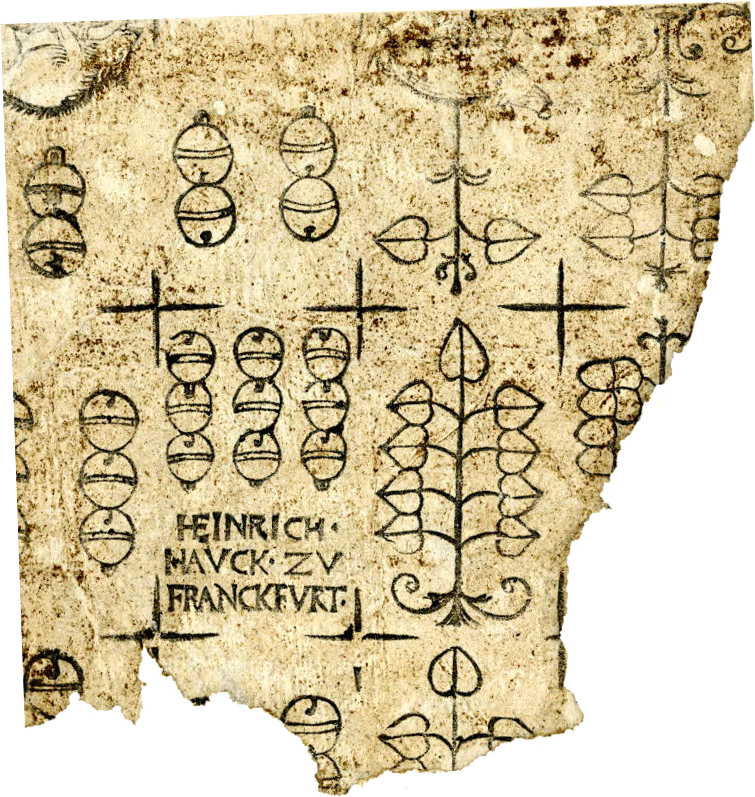
| Deuce of bells | Four of bells | Deuce of leaves | Four of leaves |
| Six of bells | Nine of bells | Nine of leaves | Eight of acorns |
| Seven(?) of bells | Eight of bells | Seven(?) of leaves | Lost card |
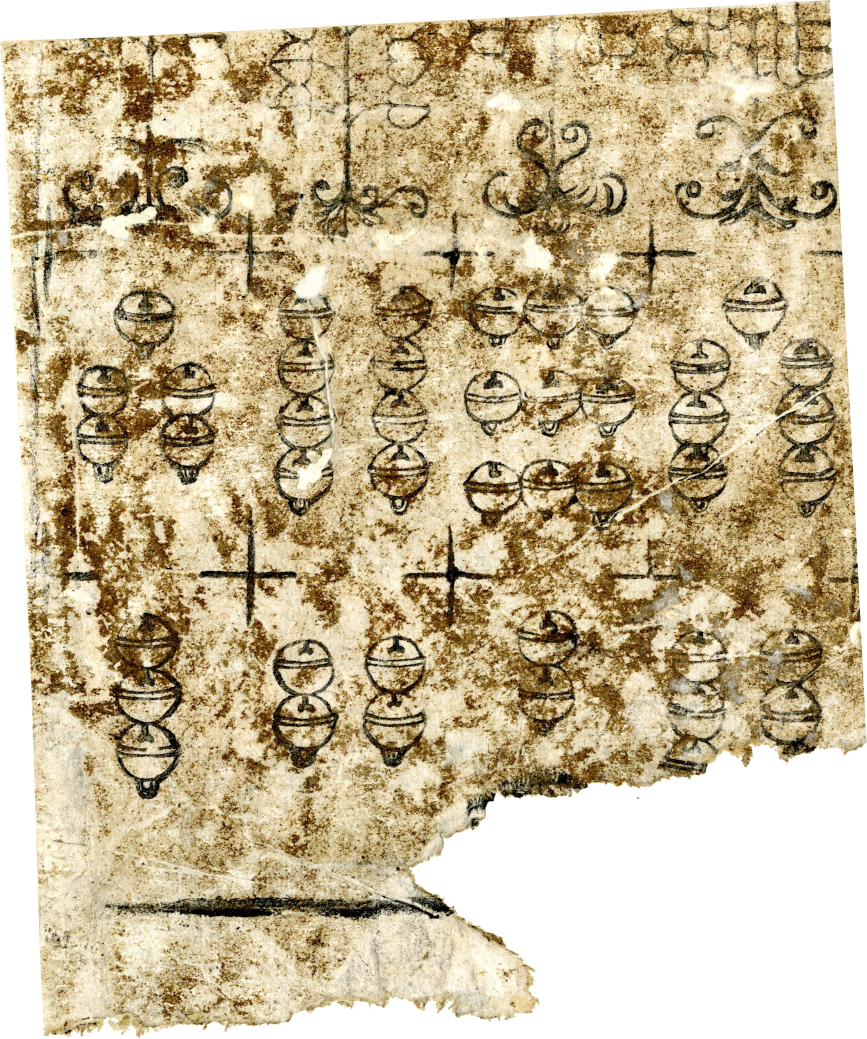
| Three(?) of leaves | Seven(?) of leaves | Five(?) of acorns | Seven(?) of acorns |
| Five of bells | Eight of bells | Nine of bells | Seven of bells |
| Three of bells | Four of bells | Deuce of bells | Six of bells |
A third fragment, 1895,0122.26, is unattributed in the British Museum, but is shown to be by the same maker by having the exact same designs for the over-knaves of acorns, leaves and hearts as a sheet fragment in the USPC collection (though not from the same woodblock). It also has the same card dimensions, down to measurement and rounding errors: 47×75 mm, as well as the uncommon feature of adding a slightly curved centerline to the “leaves” suit symbol. As the selection of cards as far as preserved is entirely nonoverlapping, it would be tempting to see the fragments as part of the same deck as one of the two above. The only argument against it is that the plus-signs separating the cards differ in size and style. The nonoverlapping card selection might alternatively be due to a choice that could be retained across different decks: the 48 cards are printed from two woodblocks both containing 4 rows of six cards each. The sixteen most complex cards – courts and banner tens – are placed on one block, alongside the eight pip cards of one suit. Hearts might have been chosen because the amount of free space on these cards made it common to put some form of maker’s marks on some of them (in this case a dog on the nine of hearts; the contemporary deck by Paulus Zaunberger has a similar dog on the six of hearts, a monogram on the nine of hearts and a banner with the year on the eight of hearts).

| Lost card | Lost card | Unidentified card | Ober of bells? | Unidentified card |
| Unidentified card | Ober of acorns | King of bells | Ober of hearts | Nine of hearts |
| Lost card | Ober of leaves | King of acorns | Unter of leaves | Eight of hearts |
The USPC fragment mentioned above contains from one to three copies of each card. It has over-knaves of the same design as the unattributed BM fragment, but different designs for the kings. Two of its three copies of a deuce preserve the makers name ‘henrich hauck’. One of these is dated 1586, the other 1585! They also contain a coat of arms identical to the one on the three of roses on the deck described in the main section of this page.
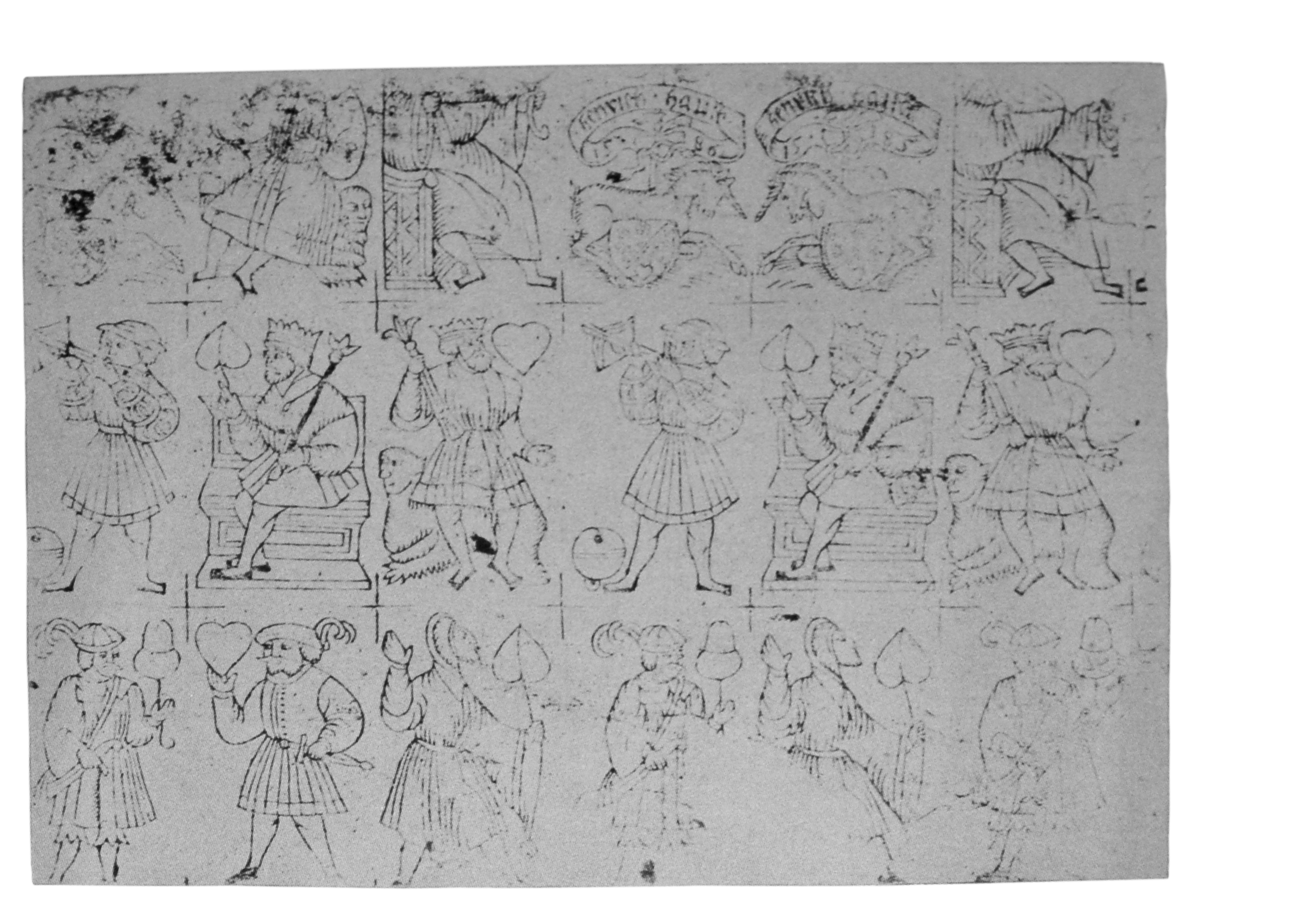
| Deuce of acorns(?) | King of bells | King of acorns | Deuce of acorns(?) | Deuce of acorns(?) | King of acorns | King of bells |
| Unter of bells | King of leaves | King of hearts | Unter of bells | King of leaves | King of hearts | Unter of bells |
| Ober of acorns | Ober of hearts | Ober of leaves | Ober of acorns | Ober of leaves | Ober of acorns | Unidentified card |
Yet another German suited deck attributed to Heinrich Hauk is dated 1595 and contains more sophisticated designs but still with the standard German suits and structure. This too has banner tens, but here the banners are held by women, as in the deck by Peter Flötner, and the kings are on horseback. The few preserved pip cards all contain vignette illustrations also in the style of Flötner.
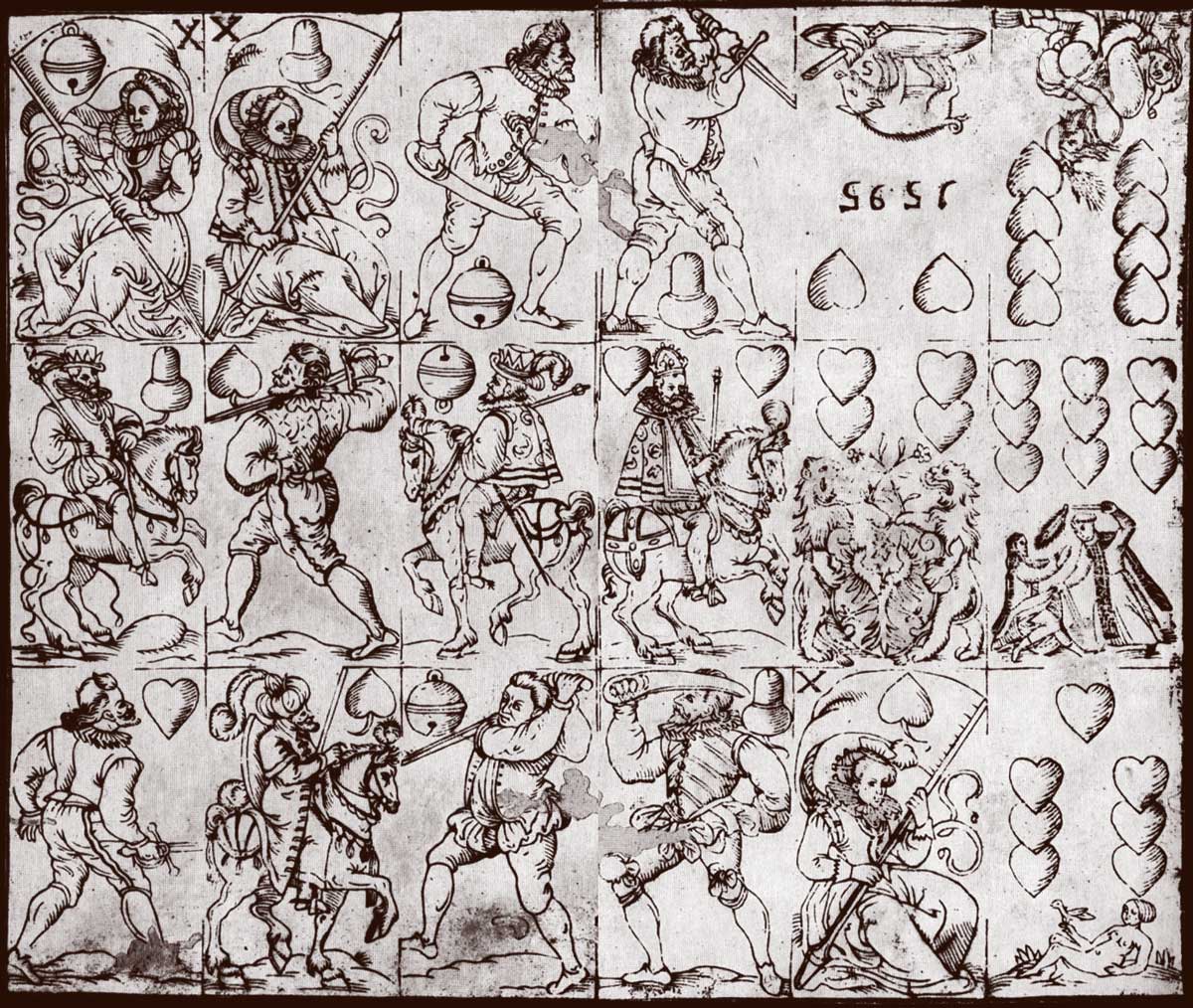
| Banner of bells | Banner of acorns | Unter of bells | Unter of acorns | Deuce of hearts | Eight of hearts |
| King of acorns | Ober of leaves | King of bells | King of hearts | Four of hearts | Nine of hearts |
| Ober of hearts | King of leaves | Ober of bells | Ober of acorns | Banner of leaves | Seven of hearts |
French suited deck
Yet another case where both the Cary collection and the British Museum have published sheet fragments which seem to form parts of the same deck consists of a quite different type of cards. These cards have French suits and court card structure, and belong to the so-called Flemish pattern. The court cards are named, but the spellings are very corrupted.
The Cary fragments contains all kings and queens. As these are not coloured, they lack suit symbols, but the suits corresponding to each person is known from other decks of the same pattern. The top row contains, from left to right:
- King of diamonds – Charlemagne. Though the preserved part of this card is quite minute, it confirms the figure expected from the pattern by containing a shield with the coat of arms split between fleur-de-lys and the imperial eagle.
- King of spades – David. The name is spelled davit, and his harp is visible in the lower right.
- King of hearts – Julius Caesar. The name is spelled ivlivscecar, and he holds a shield and a banner both showing the imperial eagle.
- Queen of clubs – Penthesilea. The name is corrupted to pentharilee.
Second row:
- Queen of spades – Bathsheba. The name is corrupted to bersapei (via “bersabee” found on other cards of this pattern).
- Queen of diamonds – Lucretia. The name is spelled lvcresse.
- King of clubs – Hector. The name is spelled hectora.
- Queen of hearts – Helen. The name is spelled heleine.
The narrow strip of a third row contains a second copy of Hector, Lucretia and Bathsheba, as well as an unknown court card which must be a knave as it differs from all kings and queens. These cards are upside-down with regards to the other rows, so it is their bottom edges that are preserved. This is highly unusual; while blocks with cards in both orientations are common, they tend to have the bottom edge of the cards oriented towards the nearest edge of the woodblock so that the carver didn’t have to work on the far side of the woodblock in order to see the designs in their upright orientation, not the opposite as here.
The BM fragments on the other hand just repeats the same two cards, the knaves of hearts and diamonds, over and over. Their names are written siprieh romam (possibly “Scipio the Roman”) and capitai nefelix (“Captain Felix”). Neither of them matches the knave fragment on the Cary sheet, but the feet of the knave of hearts are in approximately the same position.
Yale states that the cards of the Cary fragment are 60 × 90 mm, but this turns out to be a very approximate measurement. Their high quality scan makes it possible to correct this to 59 × 97 mm when measured from card separator to card separator, and 54 × 92 mm when measuring the internal borders. The latter are the exactly same measurements as British Museum gives for their cards. Assuming that the full sheets contained four rows of five cards each, the longest dimension of the block would be the same as that of the 1585 miniature deck blocks, while the shorter dimension would be slightly smaller.
♦
♠
♥
♣
♠
♦
♣
♥
♣
♦
♠
With 20 cards to a block, the Cary sheet would originally have held all kings and queens plus the two black knaves twice each. As the BM sheet when complete would have held ten copies each of the red knaves, five copies of the first sheet would have to be printed for each of the second. This combination would produce ten sets of court cards; the pip cards in French suited packs were created solely by stencils of the same type used to colour the woodblock printed court cards.
Sixteen-suited deck
The British Museum also holds a group of eleven large and small fragments of uncut sheets from a most unusual deck. These are unattributed there, but there is sufficient evidence that they come from the same workshop as the various cards signed by Hauk.
None of the fragments cover an entire sheet, but three fragments from two imprints of the same block can be pieced together to show that they form a “panel” of four cards by four. All other fragments are consistent with this layout, which is typical of Hauk with a thick outline around the panel, but only thinner plus-shaped separators at the card corners as internal divisions between the cards. Two such panels side by side would fill the exact same area as the miniature cards described above.
Not only the technique and layout is similar, but also the overall style as well as several details of execution. They share the particular way of drawing feet and swords sheaths, the kings share the same variety of thrones, and even several instances of identical poses. If the cards are not by Hauk personally, they must as a minimum be a contemporary creation from the same workshop.


